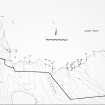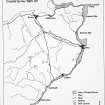Following the launch of trove.scot in February 2025 we are now planning the retiral of some of our webservices. Canmore will be switched off on 24th June 2025. Information about the closure can be found on the HES website: Retiral of HES web services | Historic Environment Scotland
Rattar
Cairn (Period Unassigned), Stone Setting (Neolithic) - (Bronze Age)
Site Name Rattar
Classification Cairn (Period Unassigned), Stone Setting (Neolithic) - (Bronze Age)
Alternative Name(s) Rattar East; Dun 015
Canmore ID 8910
Site Number ND27SW 4
NGR ND 2492 7371
NGR Description ND 2492 7371 and ND 2490 7370
Datum OSGB36 - NGR
Permalink http://canmore.org.uk/site/8910
- Council Highland
- Parish Dunnet
- Former Region Highland
- Former District Caithness
- Former County Caithness
ND27SW 4 2492 7371 and 2490 7370
'A'. An oval grassy mound lying NE-SW and measuring 45' by 30' by 5' high, was partially opened by Johm Nicolson, Nybster, who found 'a passage 4ft deep by 2ft wide, extending along it from the SW end, faced with slabs set on end and covered by flat stones for lintels'. In the passage were a stone pounder, two split bones and shells of edible molluscs.
'B'. Thirty feet to the SW the heads of three large slabs, all facing N-S, project through the turf. Two are in line and one is a short distance to the rear, opposite the space between the two slabs in front. This may be the remnant of a chambered cairn.
RCAHMS 1911
'A' is a cairn. Four thin slabs are scattered over the mound, but otherwise it is featureless, with no evidence of the passage surviving. The slabs of 'B' remain in situ but it is not possible to say whether or not they represent the remains of a chambered cairn.
Resurveyed at 1/2500.
Visited by OS 1 March 1965.
'A'is a grass-covered cairn about 15m by 10m by 1.6m high, the core of which is exposed in a ploughed field, and stones are scattered throughout the area.
'B' consists of traces of a reduced mound with slabs projecting.
C E Batey 1982.
'A' measures 18m WSW-ENE by 13m and 1.5m high. Random slabs lie on the surface and packed, fragmented slabs are visible in the disturbed centre. The SE side may have been truncated by rig and furrow cultivation.
'B' lies about 4m WSW of 'A' and consists of three slabs aligned E-W, whose edges project through the turf. Two are in line, 1.2m apart and measure respectively 1m by 0.3m high and 0.9m by 0.2m high. The third slab is 1.8m to the SSW, opposite the space between the other two, and measures 0.3m by 0.1m high. The purpose of the setting is not obvious. Visited by OS 24 April 1982.
In September 1967, Mr R S Murray wrote to T C Lethbridge at University Museum, Cambridge, relating that he had dug into an unexamined cairn in Caithness to a depth of 3ft. At this depth he came across two 'shelves' and digging deeper, he encountered a cavity in which were bones, shells, and some pieces of metal, all of which he sent to Cambridge. The matter was referred to R B K Stevenson at the NMAS, Edinburgh, who asked Murray for the identification of the cairn. This transpired to be at Rattar, and was taken to be the chambered cairn there (ND27SW 3, CAT 45), and the bones were said to be those of a dog.
It appears that Murray must have dug at the cairn again in 1968, as the next correspondence in April 1969 states that Dr Lunt had examined the skulls from Rattar implying a neolithic date, as it was still presumed that they were from the chambered cairn. A Fenton, from the National Museum of Antiquities of Scotland (NMAS), visited and photographed the mound in October 1969. In October 1988, while investigating the chambered cairn ND27SW 3, J L Davidson and A S Henshall had it confirmed by the farmer at Rattar that the mound Murray had dug into was that opened by John Nicolson in 1907, and this was confirmed by the photographs taken by Dr Fenton and Murray himself (NMRS:CA/519-23). In one of these photographs can be seen two spaced upright slabs indicative of an O-C chamber. The mound itself is oblong on plan measuring about 15m NE-SW by 11m, and is 1.6m high. Murray's excavation has been filled in, but thrown-out slabs lie adjacent to it. There are no identifications of Nicolson's excavation other than the three slabs set some 4m to the SW of the mound.
Visited by RCAHMS (J L D) 20 October 1988; Information contained in letter from R S Murray, 34 Beechwood Road, Blackburn, W Lothian, to T C Lethbridge, Cambridge University, 7 September 1967; from R B K Stevenson, National Museum of Antiquities, Edinburgh, to R S Murray, 25 September 1967 and 29 November 1967; from A S Henshall, NMAS, to R S Murray, 21 April 1969 and 20 October 1969.
Field Visit (1911)
'A'. An oval grassy mound lying NE-SW and measuring 45' by 30' by 5' high, was partially opened by John Nicolson, Nybster, who found 'a passage 4ft deep by 2ft wide, extending along it from the SW end, faced with slabs set on end and covered by flat stones for lintels'. In the passage were a stone pounder, two split bones and shells of edible molluscs.
'B'. Thirty feet to the SW the heads of three large slabs, all facing N-S, project through the turf. Two are in line and one is a short distance to the rear, opposite the space between the two slabs in front. This may be the remnant of a chambered cairn.
RCAHMS 1911
Field Visit (1 March 1965)
'A' is a cairn. Four thin slabs are scattered over the mound, but otherwise it is featureless, with no evidence of the passage surviving. The slabs of 'B' remain in situ but it is not possible to say whether or not they represent the remains of a chambered cairn.
Resurveyed at 1/2500.
Visited by OS 1 March 1965.
Project (1980 - 1982)
Field Visit (24 April 1982)
'A' measures 18m WSW-ENE by 13m and 1.5m high. Random slabs lie on the surface and packed, fragmented slabs are visible in the disturbed centre. The SE side may have been truncated by rig and furrow cultivation.
'B' lies about 4m WSW of 'A' and consists of three slabs aligned E-W, whose edges project through the turf. Two are in line, 1.2m apart and measure respectively 1m by 0.3m high and 0.9m by 0.2m high. The third slab is 1.8m to the SSW, opposite the space between the other two, and measures 0.3m by 0.1m high. The purpose of the setting is not obvious. Visited by OS 24 April 1982.
Field Visit (1982)
'A'is a grass-covered cairn about 15m by 10m by 1.6m high, the core of which is exposed in a ploughed field, and stones are scattered throughout the area.
'B' consists of traces of a reduced mound with slabs projecting.
C E Batey 1982.
Field Visit (20 October 1988)
In September 1967, Mr R S Murray wrote to T C Lethbridge at University Museum, Cambridge, relating that he had dug into an unexamined cairn in Caithness to a depth of 3ft. At this depth he came across two 'shelves' and digging deeper, he encountered a cavity in which were bones, shells, and some pieces of metal, all of which he sent to Cambridge. The matter was referred to R B K Stevenson at the NMAS, Edinburgh, who asked Murray for the identification of the cairn. This transpired to be at Rattar, and was taken to be the chambered cairn there (ND27SW 3, CAT 45), and the bones were said to be those of a dog.
It appears that Murray must have dug at the cairn again in 1968, as the next correspondence in April 1969 states that Dr Lunt had examined the skulls from Rattar implying a neolithic date, as it was still presumed that they were from the chambered cairn. A Fenton, from the National Museum of Antiquities of Scotland (NMAS), visited and photographed the mound in October 1969. In October 1988, while investigating the chambered cairn ND27SW 3, J L Davidson and A S Henshall had it confirmed by the farmer at Rattar that the mound Murray had dug into was that opened by John Nicolson in 1907, and this was confirmed by the photographs taken by Dr Fenton and Murray himself (NMRS:CA/519-23). In one of these photographs can be seen two spaced upright slabs indicative of an O-C chamber. The mound itself is oblong on plan measuring about 15m NE-SW by 11m, and is 1.6m high. Murray's excavation has been filled in, but thrown-out slabs lie adjacent to it. There are no identifications of Nicolson's excavation other than the three slabs set some 4m to the SW of the mound.
Visited by RCAHMS (J L D) 20 October 1988; Information contained in letter from R S Murray, 34 Beechwood Road, Blackburn, W Lothian, to T C Lethbridge, Cambridge University, 7 September 1967; from R B K Stevenson, National Museum of Antiquities, Edinburgh, to R S Murray, 25 September 1967 and 29 November 1967; from A S Henshall, NMAS, to R S Murray, 21 April 1969 and 20 October 1969.
































